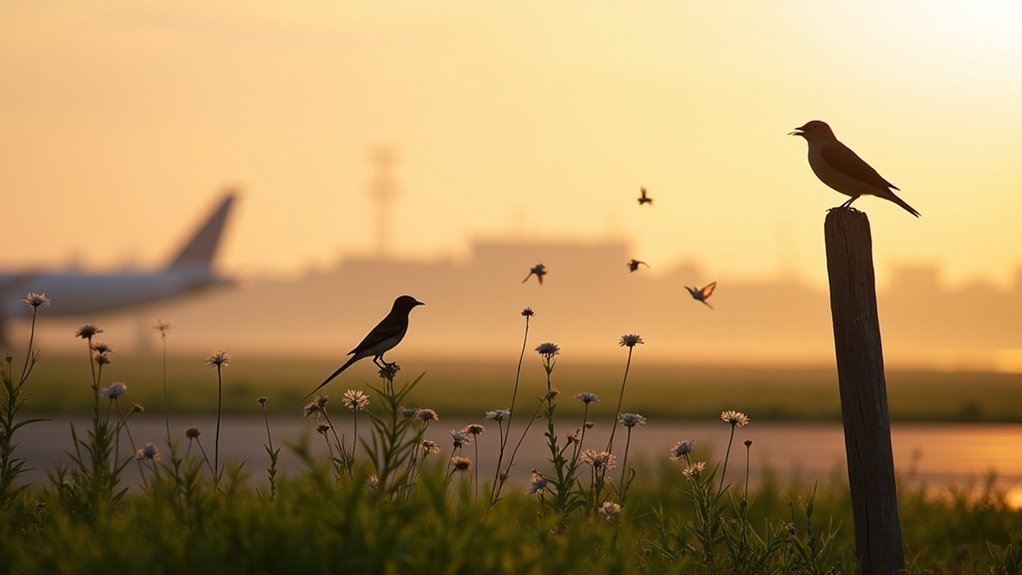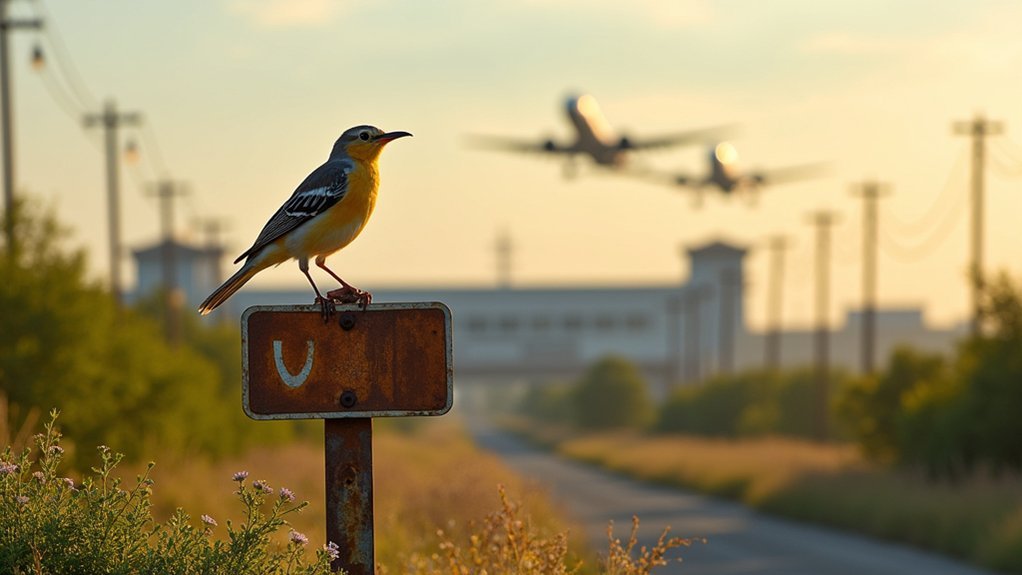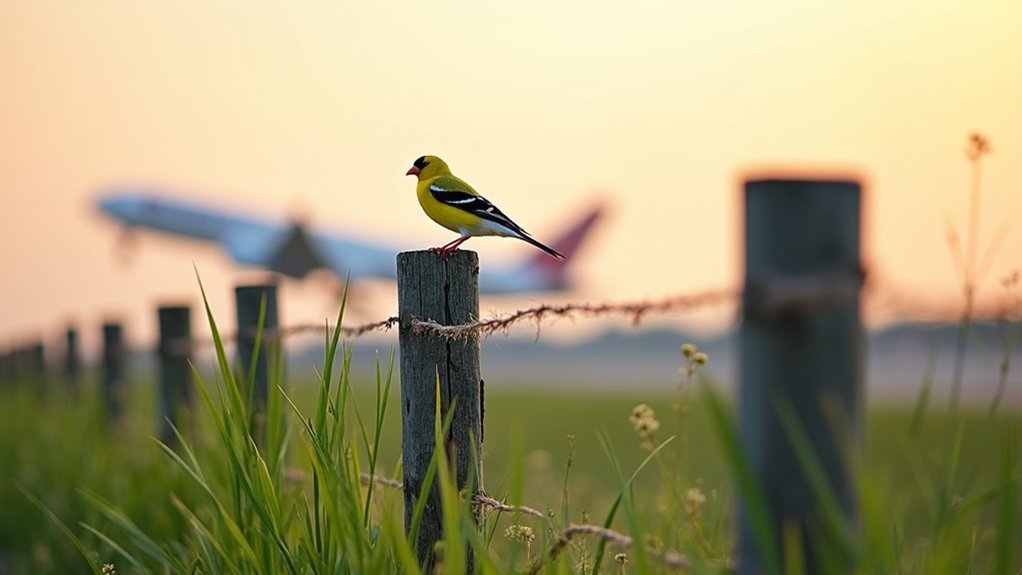Near airports, you’ll find five remarkable bird song adaptations: European starlings shifting to higher frequencies, dawn chorus singers starting before 6am, blackbirds modifying their melodies, mockingbirds incorporating aircraft sounds, and various species singing earlier to avoid peak noise. These resilient urban birds demonstrate impressive vocal flexibility by timing their songs strategically and adjusting pitch to overcome aircraft noise. Their musical adaptations showcase nature’s extraordinary ability to thrive amid human-created challenges.
5 Best Urban Bird Songs Near Airport Areas

While surrounded by the deafening roar of aircraft, urban birds near airports have developed remarkable adaptations to guarantee their songs are heard.
You’ll notice robins, blackbirds, cuckoos, and blue tits starting their dawn chorus before 6 am, cleverly avoiding the peak of airport noise pollution.
These urban birds have evolved a fascinating strategy – singing earlier than their rural counterparts to prevent their melodies from being drowned out by planes that generate sounds four times louder than their natural calls.
Species that typically sing later in the morning have shown the strongest modifications to their singing times, demonstrating their resilience in these challenging environments.
While this adaptation helps their communication and territory defense, it comes at a cost, requiring more energy and potentially affecting their ability to find food.
How European Starlings Adapt Their Songs in High-Noise Environments
European Starlings showcase particularly impressive vocal adaptability when faced with the thunderous sounds of passing aircraft. You’ll notice these resourceful birds shift their songs to higher frequencies, preventing their vocalizations from being drowned out by the low-frequency rumble of planes.
| Adaptation | Purpose |
|---|---|
| Higher frequency songs | Avoids overlap with aircraft noise |
| Earlier dawn chorus | Communicates before peak traffic |
| Song modifications | Varies with noise levels |
| Behavioral plasticity | Demonstrates urban areas resilience |
| Adjusted vocalization | Maintains territorial effectiveness |
These adaptations don’t come without cost—starlings expend more energy to compete in these challenging acoustic environments. By shifting their singing times and adjusting their vocal range, these urban specialists have found ways to thrive despite the constant disruption of airport noise levels.
The Dawn Chorus Shift: Earlier Singing Times Near Runways

As the first rays of sunlight peek over the horizon, birds near airport runways have already begun their morning concerts, well before their rural counterparts have stirred.
You’ll notice this dawn chorus adaptation particularly in urban areas with high aircraft traffic—birds start singing before 6 am to avoid competing with deafening runway noise.
This strategic shift is most dramatic in bird species that typically vocalize later in the morning. Research across major airports in Spain and Germany shows a direct correlation: more flights equal earlier singing times.
Robins, blackbirds, cuckoos, and blue tits each respond differently, with the most noise-sensitive species making the greatest adjustments.
While this early dawn chorus helps birds communicate effectively, it’s not without cost—these early risers sacrifice valuable foraging time for their musical performances.
Higher Frequency Melodies: Blackbird Adaptations to Aircraft Noise
Beyond adjusting their morning alarm clocks, blackbirds have developed another remarkable strategy near airports—they’ve literally changed their tune.
You’ll notice these resourceful birds have shifted their songs to higher frequency melodies to rise above the rumble of aircraft noise. This adaptation allows them to maintain effective communication with potential mates and rivals despite the challenging acoustic environment.
While impressive, this vocal flexibility comes at a cost. The higher pitches require more energy from blackbirds, potentially affecting their overall health.
The vocal gymnastics blackbirds perform to overcome airport noise may silently tax their bodies over time.
Nevertheless, this remarkable singing behavior demonstrates their exceptional adaptability in urban areas. These adjustments aren’t just interesting quirks—they’re essential survival tactics that showcase the birds’ resilience and behavioral plasticity when faced with human-generated noise pollution.
Urban Mockingbirds: Masters of Mimicking City and Airport Sounds

While blackbirds modify their pitch, mockingbirds take adaptation to an entirely different level near airports.
You’ll notice these remarkable urban mockingbirds incorporate aircraft sounds directly into their vocal repertoire, demonstrating extraordinary behavioral plasticity in noisy environments.
When you listen carefully at dawn or dusk, you’ll hear how these avian mimics blend natural calls with man-made sounds to create distinctive urban melodies.
They’ve developed impressive strategies to attract mates despite overwhelming noise pollution. By adjusting their singing timing and frequency, mockingbirds guarantee their territorial messages aren’t masked by jet engines and traffic.
This adaptability explains why you’ll find mockingbirds thriving in urban areas where other species struggle.
Their talent for learning and imitating surrounding sounds represents a masterclass in communication resilience amid increasing urbanization.
Frequently Asked Questions
What Birds Sing the Prettiest Songs?
You’ll find the European Nightingale, Common Blackbird, Lyric Nightingale, Song Sparrow, and American Robin sing the prettiest songs. These birds create melodious, intricate warbles that’ll captivate your ears with their sweet diversity.
What Bird Sounds Like Laughing in Texas?
You’ll often hear the Northern Mockingbird’s laugh-like call in Texas. The Common Loon, Yellow-billed Cuckoo, Great-tailed Grackle, and Green Jay also produce sounds that you might interpret as laughing vocalizations.
What Bird Song Sounds Like an Alarm?
The red-shouldered hawk produces a distinct alarm-like “kee-aah” call. You’ll also recognize the blue jay’s piercing alerts and the northern mockingbird’s repetitive warning chirps when they’re defending territory or spotting predators nearby.
What North American Bird Has the Most Beautiful Song?
You’ll often hear the Northern Mockingbird praised for having North America’s most beautiful song. It’s impressive because it can mimic up to 200 other bird songs and sounds with remarkable clarity and variation.
In Summary
You’ll notice that urban birds near airports showcase remarkable resilience in adapting their songs. They’ve shifted to earlier dawns, raised their pitches, and even mimicked mechanical sounds to overcome the constant aircraft noise. Whether it’s the European Starling’s modified melodies or the Mockingbird’s airport-inspired repertoire, these feathered musicians are constantly evolving their voices to guarantee they’re heard in our increasingly noisy urban environments.





Leave a Reply